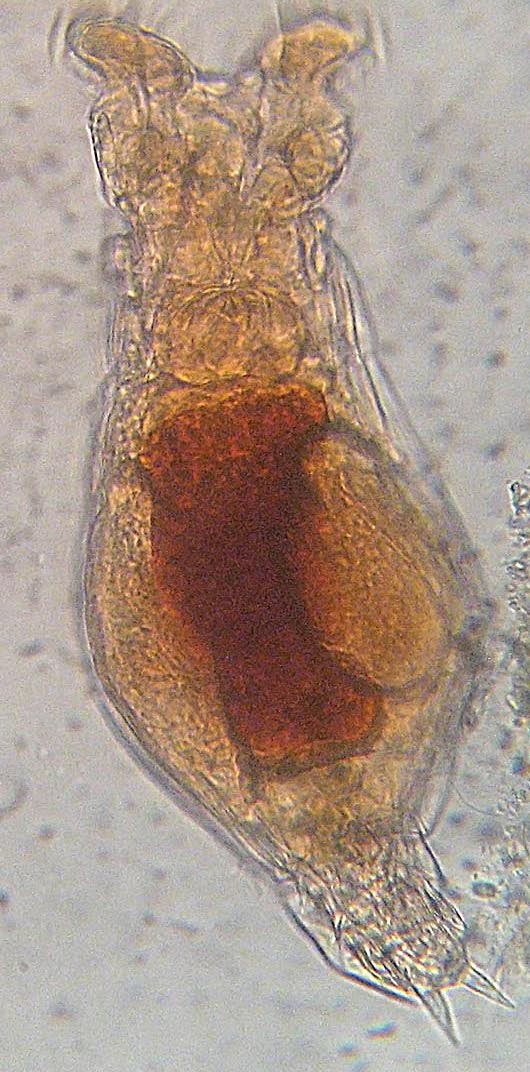Link to Species and Speciation Student Learning Guide handout.
1. Introduction
Darwin’s theory of natural selection explains how adaptations come about. But how do we explain the incredible diversity of life? How can we explain the emergence of over 8,000,000 different species? And, even more fundamentally, what is a species?
2. Species: An Interactive Reading
Even though you might not know some of the terms and definitions in the passages below, you’ll learn best by answering the questions and doing some of your own thinking. Just do your best, and don’t worry about getting things wrong. It’s part of the learning process.
[qwiz qrecord_id=”sciencemusicvideosMeister1961-Species, Interactive Reading”]
[h]Species: An interactive reading
[q]Here are a few different types of dogs.
How many species are shown above?
[c]McKgIM KgIMKg[Qq][c]MsKgIMKgIMKg[Qq][c]Mw==
Cg==[Qq][f]VGhhdCYjODIxNztzIGNvcnJlY3QuIFRoZSBHZXJtYW4gU2hlcGhlcmQsIEdvbGRlbiBSZXRyaWV2ZXIsIGFuZCBQb29kbGUgc2hvd24gYWJvdmUgYXJlIGRpZmZlcmVudCBicmVlZHMsIG9yIHZhcmlldGllcywgb2YgdGhlIGRvbWVzdGljYXRlZCBkb2cswqA=Q2FuaXMgbHVwdXMgZmFtaWxpYXJpcy4gVGhlIGRvbWVzdGljYXRlZCBkb2cgaXMgaXRzZWxmIGEgc3ViZ3JvdXAgb2YgYSBsYXJnZXIgc3BlY2llcyB0aGF0IGluY2x1ZGVzIGJvdGggd29sdmVzICg=Q2FuaXMgbHVwdXM=LCB3aXRoIHNldmVyYWwgc3Vic3BlY2llcyksIGFuZCB0aGUgZG9tZXN0aWNhdGVkIGRvZywgd2l0aCBodW5kcmVkcyBvZiBhcnRpZmljaWFsIGJyZWVkcy4=
[Qq]So what is a species?
[f]Tm8uIFRoZSBHZXJtYW4gU2hlcGhlcmQsIEdvbGRlbiBSZXRyaWV2ZXIsIGFuZCBQb29kbGUgc2hvd24gYWJvdmUgYXJlIGRpZmZlcmVudCBicmVlZHMsIG9yIHZhcmlldGllcywgb2YgdGhlIGRvbWVzdGljYXRlZCBkb2cswqA=Q2FuaXMgbHVwdXMgZmFtaWxpYXJpcy4gVGhlIGRvbWVzdGljYXRlZCBkb2cgaXMgaXRzZWxmIGEgc3ViZ3JvdXAgb2YgYSBsYXJnZXIgc3BlY2llcyB0aGF0IGluY2x1ZGVzIGJvdGggd29sdmVzICg=Q2FuaXMgbHVwdXM=LCB3aXRoIHNldmVyYWwgc3Vic3BlY2llcyksIGFuZCB0aGUgZG9tZXN0aWNhdGVkIGRvZywgd2l0aCBodW5kcmVkcyBvZiBhcnRpZmljaWFsIGJyZWVkcy4=
[Qq]So what is a species?
[f]Tm8uIFRoZSBHZXJtYW4gU2hlcGhlcmQsIEdvbGRlbiBSZXRyaWV2ZXIsIGFuZCBQb29kbGUgc2hvd24gYWJvdmUgYXJlIGRpZmZlcmVudCBicmVlZHMsIG9yIHZhcmlldGllcywgb2YgdGhlIGRvbWVzdGljYXRlZCBkb2cswqA=Q2FuaXMgbHVwdXMgZmFtaWxpYXJpcy4gVGhlIGRvbWVzdGljYXRlZCBkb2cgaXMgaXRzZWxmIGEgc3ViZ3JvdXAgb2YgYSBsYXJnZXIgc3BlY2llcyB0aGF0IGluY2x1ZGVzIGJvdGggd29sdmVzICg=Q2FuaXMgbHVwdXM=LCB3aXRoIHNldmVyYWwgc3Vic3BlY2llcyksIGFuZCB0aGUgZG9tZXN0aWNhdGVkIGRvZywgd2l0aCBodW5kcmVkcyBvZiBhcnRpZmljaWFsIGJyZWVkcy4=
[Qq]So what is a species?
[q labels = “top”]There are several ways of defining the term species. We’re going to start with what’s called the biological species concept, which defines a species as
- A group of individuals or populations that share a common ____________, and which is ______________ from other such groups.
- A population that can _______________ to produce ___________ offspring.
[l]fertile
[fx] No, that’s not correct. Please try again.
[f*] Great!
[l]gene pool
[fx] No, that’s not correct. Please try again.
[f*] Correct!
[l]isolated
[fx] No, that’s not correct. Please try again.
[f*] Great!
[l]interbreed
[fx] No, that’s not correct. Please try again.
[f*] Good!
[q]So, with the biological species concept in mind, explain why all breeds of dogs, including the three shown below, are all members of the same species. Write out your answer, and then check it against what you’ll see after clicking the button below.
[c]U2hvdyB0aG UgYW5zd2Vy[Qq]
[f]QWxsIGRvZ3MgYXJlIG1lbWJlcnMgb2YgdGhlIHNhbWUgc3BlY2llcyBiZWNhdXNlIHRoZXkgbWFrZSB1cCBhIHNpbmdsZSBnZW5lIHBvb2wuIEFsbCBkb2dzLCBkZXNwaXRlIHRoZWlyIGRpZmZlcmVudCBhcHBlYXJhbmNlLCBjYW4gKGFuZCB3aWxsKSBicmVlZCB3aXRoIG9uZSBhbm90aGVyIChhbmQgd2l0aCB3b2x2ZXMgYXMgd2VsbCkuIFRoaXMgZG9nL3dvbGYgZ2VuZSBwb29sIGlzIGlzb2xhdGVkIGZyb20gdGhlIGdlbmUgcG9vbHMgb2Ygb3RoZXIgc3BlY2llcyBpbiB0aGUgZG9nIGZhbWlseSAoc3VjaCBhcyBmb3hlcyBhbmQgQWZyaWNhbiB3aWxkIGRvZ3MpLg==[Qq]
[q]Just to make sure you’ve got it: A group of organisms that can naturally interbreed to produce fertile offspring is a
[hangman]
[c]c3BlY2llcw==[Qq]
[q]Below are two species of ducks, both of which are found throughout the Northern Hemisphere.
As it relates to mallards and pintails, which of the following would be the most direct consequence of the biological species concept?
[c]TWFsbGFyZHMgYW5kIHBpbnRhaWxzIHdpbGwgbmVzdCBpbiBkaWZmZXJlbnQgdHlwZXMgb2YgaGFiaXRhdC4=[Qq]
[f]Tm8uIFRoYXQgbWlnaHQgYmUgdHJ1ZSwgYnV0IG90aGVyIGNob2ljZXMgb24gdGhpcyBsaXN0IGFyZSBtb3JlIGRpcmVjdGx5IHJlbGF0ZWQgdG8gdGhlIGJpb2xvZ2ljYWwgc3BlY2llcyBjb25jZXB0Lg==[Qq]
[c]TWFsbGFyZHMgYW5kIHBpbnRhaWxzIHdpbGwgbm90IGJl IGFibGUgdG8gYnJlZWQgd2l0aCBvbmUgYW5vdGhlci4=[Qq]
[f]RXhhY3RseS4gQmFzZWQgb24gdGhlIGJpb2xvZ2ljYWwgc3BlY2llcyBjb25jZXB0LCBlYWNoIHNwZWNpZXMgaGFzIGEgc2VwYXJhdGUgZ2VuZSBwb29sLCB3aGljaCBtZWFucyB0aGF0IHRoZXkgd29uJiM4MjE3O3QgYmUgYWJsZSB0byBzdWNjZXNzZnVsbHkgaW50ZXJicmVlZCAoc29tZXRoaW5nIHdlJiM4MjE3O2xsIGV4cGFuZCB1cG9uIGJlbG93KS4=[Qq]
[c]U29tZSBwcmVkYXRvcnMgd2lsbCBwcmVmZXIgdG8gcHJleSBvbiBtYWxsYXJkcywgd2hpbGUgb3RoZXJzIHdpbGwgcHJlZmVyIHRvIHByZXkgb24gcGludGFpbHMu[Qq]
[f]Tm8uIFRoYXQgbWlnaHQgYmUgdHJ1ZSwgYnV0IG90aGVyIGNob2ljZXMgb24gdGhpcyBsaXN0IGFyZSBtb3JlIGRpcmVjdGx5IHJlbGF0ZWQgdG8gdGhlIGJpb2xvZ2ljYWwgc3BlY2llcyBjb25jZXB0Lg==[Qq]
[c]TWFsbGFyZHMgYW5kIHBpbnRhaWxzIHdpbGwgbWlncmF0ZSB0byBkaWZmZXJlbnQgYnJlZWRpbmcgYXJlYXMgZHVyaW5nIHRoZSB3aW50ZXIu[Qq]
[f]Tm8uIFRoYXQgbWlnaHQgYmUgdHJ1ZSwgYnV0IG90aGVyIGNob2ljZXMgb24gdGhpcyBsaXN0IGFyZSBtb3JlIGRpcmVjdGx5IHJlbGF0ZWQgdG8gdGhlIGJpb2xvZ2ljYWwgc3BlY2llcyBjb25jZXB0Lg==[Qq]
[q]Read the passage below, adapted from Wikipedia:
The Bengal cat is a domestic cat breed developed to look like wild jungle cats such as leopards and ocelots. Bengal cats were developed by selective breeding from hybrids of the wild Asian leopard cat with domestic cats. These hybrids were then bred with domestic cats, with the goal of creating a cat with a highly contrasted and vividly marked coat.
Why isn’t the Bengal cat a species? Write down your answer before clicking the button below.[c]U2hvdyB0aG UgYW5zd2Vy
Cg==[Qq][f]TGlrZSBQb29kbGVzLCBvciBHZXJtYW4gU2hlcGhlcmRzLCBCZW5nYWwgY2F0cyBhcmUgYSA=YnJlZWQ=LCBhcnRpZmljaWFsbHkgY3JlYXRlZCBieSBodW1hbnMuIEJlbmdhbCBjYXRzIHdpbGwgaGFwcGlseSBpbnRlcmJyZWVkIHdpdGggYW55IG90aGVyIGJyZWVkIG9mIGNhdCwgc28gdGhlaXIgZ2VuZSBwb29sIGlzIGluIG5vIHdheSBpc29sYXRlZC4=[Qq]
[x]
[restart]
[/qwiz]
3. Talking about Species, Subspecies, Breeds, and Varieties
The interactive reading above used binomial nomenclature. Binomial nomenclature is a system that uses Latin-sounding two-part species names like Homo sapiens for humans and Canis lupus for wolves and dogs. You also read about some other groupings such as breeds or subspecies, which fall below the species level. Let’s master all these terms before going on.
Binomial Nomenclature: Every species has a two part name called a binomial (which you should italicize or underline). For sheep, the binomial is Ovis aries. For the chinook salmon, it’s Oncorhynchus tshawytscha. Each binomial consists of two parts
- a genus (Ovis or Onchorhynchus in the two preceding examples), and
- a specific epithet, such as the sapiens part of our species name, Homo sapiens.
Subspecies: As a species evolves, it can become subdivided into subpopulations. Natural selection and genetic drift can lead these subpopulations to differentiate into subspecies. For example, the wolf, Canis lupus, has 38 subspecies (which you can read more about on Wikipedia). To designate a subspecies, biologists use a trinomial. For example, the Tundra wolf is Canis lupus albus, while the Arabian wolf is Canis lupus arabs. Domesticated dogs are also part of that same species, and have the trinomial Canis lupus familiaris.
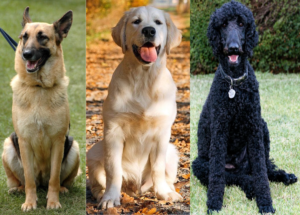
Breeds and Varieties: Between 10,000 and 15,000 years ago, humans began domesticating a variety of animals (including dogs, sheep, pigs, cattle, horses, chickens, llamas, and silkworms) and plants (including apples, walnuts, maize, peas, and hundreds of others). This domestication has involved artificial selection (or selective breeding) for a variety of traits, which has resulted in the creation of distinct breeds or varieties. The Collie, for example is a breed, or variety, of dog. A breed is an artificial creation, only maintained through the vigilance of breeders, who restrict the dogs within that breed from mating with dogs from outside that breed. The dogs don’t care: a collie would just as soon mate with a boxer as with another collie.
4. What Keeps Species Apart? Reproductive Barriers Interactive Reading
Dogs and wolves can successfully interbreed: that’s because (despite their differences), they’re members of the same species. Dogs and foxes can’t interbreed: that’s because they’re members of different species. But what keeps organisms from different species from interbreeding? Read below to find out.
[qwiz qrecord_id=”sciencemusicvideosMeister1961-Reproductive Barriers, Interactive Reading”]
[h]Reproductive Barriers
[q labels = “top”]The biological species concept is all about _______________ isolation. Essentially, what defines a species is its isolated ____________, one that doesn’t __________ with the gene pool of other species.
[l]gene pool
[fx] No, that’s not correct. Please try again.
[f*] Great!
[l]intermix
[fx] No, that’s not correct. Please try again.
[f*] Correct!
[l]reproductive
[fx] No. Please try again.
[f*] Great!
[q]But what keeps these gene pools separate? As you can see below, Grizzly bears and black bears overlap in much of their range.
What keeps these two species from interbreeding, causing their distinct gene pools to blend into one? Write down your answer before proceeding.
[q labels = “top”]The answer is reproductive barriers. These are ________ (physical, biochemical, ecological, behavioral, etc.) of the organisms within a species that do one of two things:
- They keep them from ___________ with organisms from other __________.
- If _______________ does occur, it limits the flow of ________ between the two species.
[l]breeding
[fx] No, that’s not correct. Please try again.
[f*] Good!
[l]genes
[fx] No, that’s not correct. Please try again.
[f*] Excellent!
[l]interbreeding
[fx] No. Please try again.
[f*] Great!
[l]species
[fx] No. Please try again.
[f*] Good!
[l]traits
[fx] No, that’s not correct. Please try again.
[f*] Great!
[q labels = “top”]One category of reproductive barrier is called pre-zygotic. Pre-zygotic barriers act before a _________ (a fertilized egg) is formed. These barriers prevent mating, or, if __________ occurs, prevent a zygote from __________.
Here are a few types of pre-zygotic barriers. Based on its description, label each one.
- _______________: If two species live in different areas, they won’t meet to interbreed. For example, one species of mouse might live on mountain slopes, and a second might live in valleys.
- _______________: If one species is active during the day, and a second at night, they won’t meet. Or, if one has a breeding season in the fall, and the second during the spring. they might meet, but they won’t mate.
- _______________: Animal mating is usually preceded by complex mating rituals. These include dances and songs, all of which are very specific. If individuals of two species have different mating rituals, they won’t mate. Many species markings (colors, feather patterns) are about letting males and females know that they’re of the same species, which is what starts a mating ritual.
- _______________: In animals that have internal fertilization, the sperm has to make it to the egg. If the shape of the male and female organs isn’t right, then mating can’t happen. This is specially important in flowers and insects.
- _______________: Once the sperm makes it to the egg, molecular markers on the sperm have to bind with receptors on the egg’s membrane. If these markers and receptors aren’t complementary, the egg won’t open. As a result, the sperm’s nucleus won’t enter, and fertilization won’t take place. In animals and plants that have external fertilization (fish that release egg and sperm into the water, or plants that use wind pollination) this type of barrier is especially important.
[l]Behavioral
[fx] No. Please try again.
[f*] Good!
[l]forming
[fx] No, that’s not correct. Please try again.
[f*] Excellent!
[l]Gametic
[fx] No, that’s not correct. Please try again.
[f*] Good!
[l]Habitat
[fx] No. Please try again.
[f*] Good!
[l]mating
[fx] No, that’s not correct. Please try again.
[f*] Excellent!
[l]Mechanical
[fx] No, that’s not correct. Please try again.
[f*] Excellent!
[l]Temporal
[fx] No, that’s not correct. Please try again.
[f*] Great!
[l]zygote
[fx] No, that’s not correct. Please try again.
[f*] Correct!
[q labels = “top”]Sometimes, in species that are very closely related, all of the ______________ mechanisms described in the previous card aren’t enough. As a result, members of different species do occasionally mate. Yet the gene pools of these species stay separate. How? This separation is by post-zygotic barriers. Post-zygotic barriers occur ______ zygote formation. In other words, they don’t keep two closely related species from mating, but they prevent a zygote from developing into a fertile, healthy _______.
There are three types of post-zygotic barriers. Based on its description, label each one.
- Hybrid ____________: Hybrid zygotes don’t develop into adults.
- Hybrid ___________: The hybrid offspring look healthy, but they can’t produce offspring of their own.
- Hybrid _____________: The F1s (the first generation) are fine, but when these F1s interbreed, their offspring (the F2s) are weak, sterile, fail to develop, etc.
[l]adult
[fx] No, that’s not correct. Please try again.
[f*] Good!
[l]after
[fx] No, that’s not correct. Please try again.
[f*] Correct!
[l]breakdown
[fx] No. Please try again.
[f*] Excellent!
[l]pre-zygotic
[fx] No, that’s not correct. Please try again.
[f*] Great!
[l]sterility
[fx] No. Please try again.
[f*] Excellent!
[l]inviability
[fx] No. Please try again.
[f*] Good!
[x][restart]
[/qwiz]
5. Reproductive Barriers: Checking Understanding
Identify the reproductive barriers in the examples below.
[qwiz random = “true” qrecord_id=”sciencemusicvideosMeister1961-Reproductive Barrieres, CFU”]
[h]Reproductive Barriers
[i]
[q]Two species might mate and produce offspring, but when the F1s try to produce offspring, their fertilized eggs never develop into adult F2s.
[c]cHJlLXp5Z290aWM7IGdhbWV0aWM=[Qq]
[c]cHJlLXp5Z290aWM7IHRlbXBvcmFs[Qq]
[c]cHJlLXp5Z290aWM7IG1lY2hhbmljYWw=[Qq]
[c]cG9zdC16eWdvdGljOyBo eWJyaWQgc3RlcmlsaXR5[Qq]
[c]cG9zdC16eWdvdGljOyBoeWJyaWQgYnJlYWtkb3duLg==[Qq]
[f]Tm8uIFByZS16eWdvdGljIGJhcnJpZXJzIHByZXZlbnQgZmVydGlsaXphdGlvbi4gSWYgaW5kaXZpZHVhbHMgZnJvbSBkaWZmZXJlbnQgc3BlY2llcyBwcm9kdWNlIG9mZnNwcmluZywgdGhlIGJhcnJpZXIgY2Fu4oCZdCBiZSBwcmUtenlnb3RpYw==[Qq]
[f]IE5vLiBQcmUtenlnb3RpYyBiYXJyaWVycyBwcmV2ZW50IGZlcnRpbGl6YXRpb24uIElmIGluZGl2aWR1YWxzIGZyb20gZGlmZmVyZW50IHNwZWNpZXMgcHJvZHVjZSBvZmZzcHJpbmcsIHRoZSBiYXJyaWVyIGNhbuKAmXQgYmUgcHJlLXp5Z290aWM=[Qq]
[f]IE5vLiBQcmUtenlnb3RpYyBiYXJyaWVycyBwcmV2ZW50IGZlcnRpbGl6YXRpb24uIElmIGluZGl2aWR1YWxzIGZyb20gZGlmZmVyZW50IHNwZWNpZXMgcHJvZHVjZSBvZmZzcHJpbmcsIHRoZSBiYXJyaWVyIGNhbuKAmXQgYmUgcHJlLXp5Z290aWM=[Qq]
[f]VGhhdCYjODIxNztzIHJpZ2h0LiBJZiB0aGUgRg==MQ==cyBjYW4mIzgyMTc7dCByZXByb2R1Y2UsIHRoZW4gd2UgaGF2ZSBoeWJyaWQgc3RlcmlsaXR5Lg==[Qq]
[f]Tm8uIFRoaXMgYmFycmllciBpcyBwb3N0LXp5Z290aWMsIGJ1dCB0aGUgcmVwcm9kdWN0aXZlIGJhcnJpZXIgaW52b2x2ZXMgdGhlIEY=MQ==IGdlbmVyYXRpb24uIEh5YnJpZCBicmVha2Rvd24gaW52b2x2ZXMgdGhlIEY=Mg==cyBiZWluZyB1bmFibGUgdG8gcmVwcm9kdWNlLg==[Qq]
[q]Two species of moths have slightly different pheromones (sexually attracting hormones).
[c]cHJlLXp5Z290aWM7IGdhbWV0aWM=[Qq]
[c]cHJlLXp5Z290aWM7IG1lY2hhbmljYWw=[Qq]
[c]cHJlLXp5Z290aWM7 IGJlaGF2aW9yYWw=[Qq]
[c]cG9zdC16eWdvdGljOyBoeWJyaWQgdW52aWFiaWxpdHk=[Qq]
[c]cG9zdC16eWdvdGljOyBoeWJyaWQgYnJlYWtkb3du[Qq]
[f]Tm8uIEluIGdhbWV0aWMgaXNvbGF0aW9uLCBtYXRpbmcgb2NjdXJzLCBidXQgdGhlIHNwZXJtIGNhbuKAmXQgZmVydGlsaXplIHRoZSBlZ2cu[Qq]
[f]Tm8uIEluIG1lY2hhbmljYWwgaXNvbGF0aW9uLCBtYXRpbmcgY2Fu4oCZdCBvY2N1ciBiZWNhdXNlIHJlcHJvZHVjdGl2ZSBwYXJ0cyBhcmUgc3RydWN0dXJlZCBzbyB0aGF0IGEgc3Blcm0gb3IgcG9sbGVuIGNhbuKAmXQgcmVhY2ggdGhlIGVnZy4=[Qq]
[f]RXhjZWxsZW50LiBUaGlzIGlzIGRlZmluaXRlbHkgYSBwcmUtenlnb3RpYyBiYXJyaWVyLCBhbmQsIG9mIHRoZSBjaG9pY2VzIGxpc3RlZCwgYmVoYXZpb3JhbA==IGlzIHRoZSBvbmx5IHJlYXNvbmFibGUgbWF0Y2gu[Qq]
[f]Tm8uIFBvc3Qtenlnb3RpYyBiYXJyaWVycyBmb2xsb3cgZmVydGlsaXphdGlvbiwgd2hpY2ggaW4gdGhpcyBjYXNlIG5ldmVyIHRha2VzIHBsYWNlLg==[Qq]
[f]Tm8uIFBvc3Qtenlnb3RpYyBiYXJyaWVycyBmb2xsb3cgZmVydGlsaXphdGlvbiwgd2hpY2ggaW4gdGhpcyBjYXNlIG5ldmVyIHRha2VzIHBsYWNlLg==[Qq]
[q]The mating ritual of one species of lemur seems a little weird for a second species.
[c]cHJlLXp5Z290aWM7IGh5YnJpZCBicmVha2Rvd24=[Qq]
[c]cHJlLXp5Z290aWM7 IGJlaGF2aW9yYWw=[Qq]
[c]cHJlLXp5Z290aWM7IGhhYml0YXQ=[Qq]
[c]cG9zdC16eWdvdGljOyBnYW1ldGlj[Qq]
[c]cG9zdC16eWdvdGljOyBoeWJyaWQgc3RlcmlsaXR5[Qq]
[f]Tm8uIEZpcnN0IG9mIGFsbCwgaHlicmlkIGJyZWFrZG93biBpcyBwb3N0LXp5Z290aWMuIFNlY29uZGx5LCB3aGF04oCZcyBhdCB3b3JrIGhlcmUgaXMgYSBtZWNoYW5pc20gdGhhdCBwcmV2ZW50cyBtYXRpbmcgKHNvIGl0IGhhcyB0byBiZSBwcmUtenlnb3RpYyku[Qq]
[f]TmljZSBqb2IuIFRoaXMgaXMgYSBwcmUtenlnb3RpYywgYmVoYXZpb3JhbCBiYXJyaWVyLg==[Qq]
[f]Tm8sIGJ1dCB5b3XigJlyZSBvbiB0aGUgcmlnaHQgdHJhY2suIFRoaXMgaXMgYSBwcmUtenlnb3RpYyBtZWNoYW5pc20sIGJ1dCB0aGVyZeKAmXMgbm8gZXZpZGVuY2UgdGhhdCB0aGVzZSBsZW11cnMgbGl2ZSBpbiBkaWZmZXJlbnQgaGFiaXRhdHMu[Qq]
[f]Tm8uIFJlbWVtYmVyIHRoYXQgcG9zdC16eWdvdGljIGJhcnJpZXJzIGZvbGxvdyBtYXRpbmcuIEFyZSB0aGVzZSBsZW11cnMgZ29pbmcgdG8gbWF0ZT8=[Qq]
[f]Tm8uIFJlbWVtYmVyIHRoYXQgcG9zdC16eWdvdGljIGJhcnJpZXJzIGZvbGxvdyBtYXRpbmcuIEFyZSB0aGVzZSBsZW11cnMgZ29pbmcgdG8gbWF0ZT8=[Qq]
[q]The pollen tube of one species of orchid can’t grow to reach the eggs of a second type of orchid.
[c]cHJlLXp5Z290aWM7IGh5YnJpZCBzdGVyaWxpdHk=[Qq]
[c]cHJlLXp5Z290aWM7IGhhYml0YXQ=[Qq]
[c]cG9zdC16eWdvdGljOyBoeWJyaWQgaW52aWFiaWxpdHk=[Qq]
[c]cHJlLXp5Z290aWM7 IG1lY2hhbmljYWw=[Qq]
[c]cG9zdC16eWdvdGljOyBiZWhhdmlvcg==[Qq]
[f]Tm8uIEZpcnN0IG9mIGFsbCwgaHlicmlkIHN0ZXJpbGl0eSBpcyBhIHBvc3Qtenlnb3RpYyBiYXJyaWVyLiBTZWNvbmQsIHRoaXMgaW5hYmlsaXR5IG9mIHRoZSBwb2xsZW4gdHViZSB0byByZWFjaCB0aGUgZWdnIGlzIGdvaW5nIHRvIHByZXZlbnQgZmVydGlsaXphdGlvbi4gVGhhdCBtYWtlcyBpdCBfX19fLXp5Z290aWMu[Qq]
[f]Tm8uIFlvdeKAmXJlIHJpZ2h0IGFib3V0IHByZS16eWdvdGljLCBidXQgdGhlcmXigJlzIG5vIGV2aWRlbmNlIHRoYXQgdGhlc2Ugb3JjaGlkcyBsaXZlIGluIGRpZmZlcmVudCBoYWJpdGF0cy4=[Qq]
[f]Tm8uIFRoaXMgaW5hYmlsaXR5IG9mIHRoZSBwb2xsZW4gdHViZSB0byByZWFjaCB0aGUgZWdnIGlzIGdvaW5nIHRvIHByZXZlbnQgZmVydGlsaXphdGlvbi4gVGhhdCBtYWtlcyBpdCBfX19fLXp5Z290aWMu[Qq]
[f]V2F5IHRvIGdvISBUaGlzIGlzIGFuIGV4YW1wbGUgb2YgYSBtZWNoYW5pY2FsLCBwcmUtenlnb3RpYyByZXByb2R1Y3RpdmUgYmFycmllci4=[Qq]
[f]Tm8uIERpZmZlcmVuY2VzIGluIGJlaGF2aW9yIHRoYXQgcHJldmVudCBtYXRpbmcgYXJlIGEgcHJlenlnb3RpYyBiYXJyaWVyLg==[Qq]
[q]One type of small rodent is nocturnal (active at night). The other is diurnal (active during the day).
[c]cHJlLXp5Z290aW M7IHRlbXBvcmFs[Qq]
[c]cHJlLXp5Z290aWM7IGhhYml0YXQ=[Qq]
[c]cHJlLXp5Z290aWM7IGdhbWV0aWM=[Qq]
[c]cG9zdC16eWdvdGljOyBoeWJyaWQgc3RlcmlsaXR5[Qq]
[c]cG9zdC16eWdvdGljOyBoeWJyaWQgYnJlYWtkb3du[Qq]
[f]RmFidWxvdXMhIFRoZSBkaWZmZXJlbmNlIGJldHdlZW4gbm9jdHVybmFsIGFuZCBkaXVybmFsIGxpZmVzdHlsZXMgaXMgYSB0ZW1wb3JhbCwgcHJlLXp5Z290aWMgYmFycmllci4=[Qq]
[f]Tm8uIFdoaWxlIHRoaXMgaXMgYSBwcmUtenlnb3RpYyBiYXJyaWVyLCB0aGVyZeKAmXMgbm8gZXZpZGVuY2UgdGhhdCB0aGVzZSByb2RlbnRzIGxpdmUgaW4gZGlmZmVyZW50IGhhYml0YXRzLg==[Qq]
[f]Tm8uIFdoaWxlIHRoaXMgaXMgYSBwcmUtenlnb3RpYyBiYXJyaWVyLCB0aGVyZeKAmXMgbm8gZXZpZGVuY2UgdGhhdCB0aGVzZSByb2RlbnRzIGFyZSBleHBlcmllbmNpbmcgYSBnYW1ldGljIGluY29tcGF0aWJpbGl0eSBwcm9ibGVtIHRoYXQgd291bGQgcHJldmVudCBmZXJ0aWxpemF0aW9uLg==[Qq]
[f]Tm8uIE5vdGUgdGhhdCBiZWNhdXNlIHRoZXNlIHJvZGVudHMgYXJlIGFjdGl2ZSBhdCBkaWZmZXJlbnQgdGltZXMsIHRoZXnigJlyZSB1bmxpa2VseSB0byBldmVyIG1hdGUuIFRoYXQgbWFrZXMgdGhpcyBhIF9fX19fLXp5Z290aWMgYmFycmllci4=[Qq]
[f]Tm8uIE5vdGUgdGhhdCBiZWNhdXNlIHRoZXNlIHJvZGVudHMgYXJlIGFjdGl2ZSBhdCBkaWZmZXJlbnQgdGltZXMsIHRoZXnigJlyZSB1bmxpa2VseSB0byBldmVyIG1hdGUuIFRoYXQgbWFrZXMgdGhpcyBhIF9fX19fLXp5Z290aWMgYmFycmllci4=[Qq]
[q]When two types of frogs mate, the eggs develop into tadpoles, but don’t develop into adult frogs.
[c]cHJlLXp5Z290aWM7IGJlaGF2aW9yYWw=[Qq]
[c]cHJlLXp5Z290aWM7IHRlbXBvcmFs[Qq]
[c]cHJlLXp5Z290aWM7IGh5YnJpZCBzdGVyaWxpdHk=[Qq]
[c]cG9zdC16eWdvdGljOyBnYW1ldGlj[Qq]
[c]cG9zdC16eWdvdGljOyBoeW JyaWQgaW52aWFiaWxpdHk=[Qq]
[f]Tm8uIE5vdGUgdGhhdCB0aGVzZSBmcm9ncyBhcmUgbWF0aW5nLCBhbmQgcHJvZHVjaW5nIHRhZHBvbGVzLiBUaGF0IG1lYW5zIHRoYXQgdGhlIGJhcnJpZXIgaXMgX19fXy16eWdvdGljLg==[Qq]
[f]Tm8uIE5vdGUgdGhhdCB0aGVzZSBmcm9ncyBhcmUgbWF0aW5nLCBhbmQgcHJvZHVjaW5nIHRhZHBvbGVzLiBUaGF0IG1lYW5zIHRoYXQgdGhlIGJhcnJpZXIgaXMgX19fXy16eWdvdGljLg==[Qq]
[f]Tm8uIFRoZXJlIGFyZSB0d28gcHJvYmxlbXMgd2l0aCB0aGlzIGNob2ljZS4gRmlyc3QsIHRoZSBiYXJyaWVyIGlzIHBvc3Qtenlnb3RpYy4gU2Vjb25kLCBoeWJyaWQgc3RlcmlsaXR5IGludm9sdmVzIGh5YnJpZHMgdGhhdCBncm93IHRvIGJlIGhlYWx0aHkgYWR1bHRzIChsaWtlIG11bGVzKSBidXQgd2hpY2ggY2Fu4oCZdCByZXByb2R1Y2UuIEhlcmUsIHRoZSBoeWJyaWQgb2Zmc3ByaW5nIGRvbuKAmXQgZGV2ZWxvcCBwYXN0IHRoZSB0YWRwb2xlIHN0YWdlLg==[Qq]
[f]Tm8uIFlvdeKAmXJlIHJpZ2h0IGFib3V0IOKAnHBvc3Qtenlnb3RpYyzigJ0gYnV0ICYjODIyMDtnYW1ldGljJiM4MjIxOyBpcyBhIHByZS16eWdvdGljIGJhcnJpZXIgaW4gd2hpY2ggc3Blcm0gY2Fu4oCZdCBmZXJ0aWxpemUgZWdncyB0byBwcm9kdWNlIHp5Z290ZXMuIEhlcmUgZmVydGlsaXphdGlvbiBpcyBvY2N1cnJpbmcsIGFuZCB6eWdvdGVzIGFyZSBkZXZlbG9waW5nIHVudGlsIHRoZSB0YWRwb2xlIHN0YWdlLg==[Qq]
[f]RXhjZWxsZW50LiBUaGVzZSBmcm9ncyBhcmUgZmVydGlsaXppbmcgZWFjaCBvdGhlcuKAmXMgZWdncywgYnV0IHRoZSB6eWdvdGVzIGFyZSBvbmx5IGRldmVsb3BpbmcgdG8gdGhlIHRhZHBvbGUgc3RhZ2UuIFRoYXQgbWVhbnMgdGhhdCB0aGUgYmFycmllciBpcyBwb3N0LXp5Z290aWMgaHlicmlkIGludmlhYmlsaXR5Lg==[Qq]
[q]One type of bird is ready to mate in the fall. A second is ready to mate in the spring.
[c]cHJlLXp5Z290aWM7IGh5YnJpZCBicmVha2Rvd24=[Qq]
[c]cHJlLXp5Z290aW M7IHRlbXBvcmFs[Qq]
[c]cHJlLXp5Z290aWM7IGhhYml0YXQ=[Qq]
[c]cG9zdC16eWdvdGljOyBoeWJyaWQgc3RlcmlsaXR5[Qq]
[c]cG9zdC16eWdvdGljOyBnYW1ldGlj[Qq]
[f]Tm8uIEh5YnJpZCBicmVha2Rvd24gaXMgYSBwb3N0LXp5Z290aWMgYmFycmllciwgbm90IHByZS16eWdvdGljIG9uZS4=[Qq]
[f]R29vZCBqb2IuIFRoZSBkaWZmZXJlbmNlIGluIG1hdGluZyBzZWFzb24gaXMgYW4gZXhhbXBsZSBvZiBhIHRlbXBvcmFsLCBwcmUtenlnb3RpYyByZXByb2R1Y3RpdmUgYmFycmllci4=[Qq]
[f]Tm8uIFlvdeKAmXJlIHJpZ2h0IGFib3V0IHRoZSBiYXJyaWVyIGJlaW5nIHByZS16eWdvdGljLCBidXQgdGhlcmXigJlzIG5vIGV2aWRlbmNlIHRoYXQgdGhpcyB3YXMgYmFzZWQgb24gaGFiaXRhdC4=[Qq]
[f]Tm8uIFRoZXNlIGJpcmRzIGhhdmUgZGlmZmVyZW50IG1hdGluZyBzZWFzb25zLiBEb2VzIHRoYXQgbWFrZSB0aGlzIGJhcnJpZXIgcHJlLSBvciBwb3N0LXp5Z290aWM/[Qq]
[f]Tm8uIEZpcnN0LCB0aGVzZSBiaXJkcyBoYXZlIGRpZmZlcmVudCBtYXRpbmcgc2Vhc29ucy4gRG9lcyB0aGF0IG1ha2UgdGhpcyBiYXJyaWVyIHByZS0gb3IgcG9zdC16eWdvdGljPyBTZWNvbmQsIGdhbWV0aWMgYmFycmllcnMgYXJlIHByZS16eWdvdGljIChzaW5jZSB0aGV5IHByZXZlbnQgZm9ybWF0aW9uIG9mIHp5Z290ZXMuKQ==[Qq]
[q]Male fiddler crabs wave their large claws to attract females. Each species has a slightly different wave.
[c]cHJlLXp5Z290aWM7IHRlbXBvcmFs[Qq]
[c]cHJlLXp5Z290aWM7IGh5YnJpZCBicmVha2Rvd24=[Qq]
[c]cHJlLXp5Z290aWM7 IGJlaGF2aW9yYWw=[Qq]
[c]cG9zdC16eWdvdGljOyBoeWJyaWQgc3RlcmlsaXR5[Qq]
[c]cG9zdC16eWdvdGljOyBoYWJpdGF0[Qq]
[f]Tm8uIFdoaWxlIHRoZSBiYXJyaWVyIGlzIHByZS16eWdvdGljLCB0aGVyZeKAmXMgbm8gZXZpZGVuY2UgYWJvdXQgdGhlcmUgYmVpbmcgYW55IHRpbWUtYmFzZWQgYmFycmllcnMgYmV0d2VlbiB0aGUgZGlmZmVyZW50IGZpZGRsZXIgY3JhYiBzcGVjaWVzLg==[Qq]
[f]Tm8uIFlvdeKAmXJlIHJpZ2h0IGFib3V0IHRoZSBiYXJyaWVyIGJlaW5nIHByZS16eWdvdGljLiBCdXQgaHlicmlkLWJyZWFrZG93biAodGhlIGludmlhYmlsaXR5IG9mIEY=MsKgIG9mZnNwcmluZykgaXMgYSBwb3N0LXp5Z290aWMgYmFycmllci4=[Qq]
[f]VGVycmlmaWMuIFRoZSBzcGVjaWZpY2l0eSBvZiB0aGUgY2xhdy13YXZlIHVzZWQgdG8gYXR0cmFjdCBtYXRlcyBpcyBhIGJlaGF2aW9yYWwsIHByZXp5Z290aWMgcmVwcm9kdWN0aXZlIGJhcnJpZXIu[Qq]
[f]Tm8uIFRoaW5rIGFib3V0IHRoaXMgYmVoYXZpb3ImIzgyMzA7aXMgaXQgYSBwcmUgb3IgYSBwb3N0LXp5Z290aWMgcmVwcm9kdWN0aXZlIGJhcnJpZXI/[Qq]
[f]Tm8uIFRoaW5rIGFib3V0IHRoaXMgYmVoYXZpb3ImIzgyMzA7aXMgaXQgYSBwcmUgb3IgYSBwb3N0LXp5Z290aWMgcmVwcm9kdWN0aXZlIGJhcnJpZXI/[Qq]
[q]Two species of mice are mated in the lab and produce fertile hybrid offspring, but the offspring of the hybrids (the F2s) are sterile
[c]cHJlLXp5Z290aWM7IGh5YnJpZCBicmVha2Rvd24=[Qq]
[c]cHJlLXp5Z290aWM7IGhhYml0YXQ=[Qq]
[c]cHJlLXp5Z290aWM7IGJlaGF2aW9y[Qq]
[c]cG9zdC16eWdvdGljOyBo eWJyaWQgYnJlYWtkb3du[Qq]
[c]cG9zdC16eWdvdGljOyBoeWJyaWQgc3RlcmlsaXR5[Qq]
[f]Tm8uIE5vdGUgdGhhdCB0aGUgbWljZSBhcmUgYWJsZSB0byBwcm9kdWNlIG9mZnNwcmluZy4gRG9lcyB0aGF0IG1ha2UgdGhlIGJhcnJpZXIgcHJlLXp5Z290aWMgb3IgcG9zdC16eWdvdGljPw==[Qq]
[f]Tm8uIE5vdGUgdGhhdCB0aGUgbWljZSBhcmUgYWJsZSB0byBwcm9kdWNlIG9mZnNwcmluZy4gRG9lcyB0aGF0IG1ha2UgdGhlIGJhcnJpZXIgcHJlLXp5Z290aWMgb3IgcG9zdC16eWdvdGljPw==[Qq]
[f]Tm8uIE5vdGUgdGhhdCB0aGUgbWljZSBhcmUgYWJsZSB0byBwcm9kdWNlIG9mZnNwcmluZy4gRG9lcyB0aGF0IG1ha2UgdGhlIGJhcnJpZXIgcHJlLXp5Z290aWMgb3IgcG9zdC16eWdvdGljPw==[Qq]
[f]RXhjZWxsZW50LiBJbiBoeWJyaWQgYnJlYWtkb3duLCB0aGUgRg==MQ==IGh5YnJpZCBvZmZzcHJpbmcgYXJlIGFibGUgdG8gcmVwcm9kdWNlLCBidXQgdGhlaXIgb2Zmc3ByaW5nICh0aGUgRg==Mg==cykgYXJlIGEgZ2VuZXRpYyBkZWFkIGVuZC4=[Qq]
[f]Tm8uIElmIHRoaXMgd2VyZSBoeWJyaWQgc3RlcmlsaXR5LCB0aGVuIHRoZSBoeWJyaWQgb2Zmc3ByaW5nIHdvdWxkIGJlIGluZmVydGlsZS4=[Qq]
[q]The salamanders Ambystoma tigrinum and A. maculatum live in the same areas. A. tigrinum breeds in Feb-March, A. maculatum breeds in April-May.
[c]cHJlLXp5Z290aW M7IHRlbXBvcmFs[Qq]
[c]cHJlLXp5Z290aWM7IGh5YnJpZCBicmVha2Rvd24=[Qq]
[c]cHJlLXp5Z290aWM7IGhhYml0YXQ=[Qq]
[c]cG9zdC16eWdvdGljOyBoeWJyaWQgc3RlcmlsaXR5[Qq]
[c]cG9zdC16eWdvdGljOyBnYW1ldGlj[Qq]
[f]R29vZCBqb2IuIFRoZSBkaWZmZXJlbmNlIGluIG1hdGluZyBzZWFzb24gaXMgYW4gZXhhbXBsZSBvZiBhIHRlbXBvcmFsLCBwcmUtenlnb3RpYyByZXByb2R1Y3RpdmUgYmFycmllci4=[Qq]
[f]Tm8uIEh5YnJpZCBicmVha2Rvd24gaXMgYSBwb3N0LXp5Z290aWMgYmFycmllciwgbm90IHByZS16eWdvdGljIG9uZS4=[Qq]
[f]Tm8uIFlvdeKAmXJlIHJpZ2h0IGFib3V0IHRoZSBiYXJyaWVyIGJlaW5nIHByZS16eWdvdGljLCBidXQgdGhlcmXigJlzIG5vdCBldmlkZW5jZSB0aGF0IHRoaXMgd2FzIGJhc2VkIG9uIGhhYml0YXQu[Qq]
[f]Tm8uIFRoZXNlIGJpcmRzIGhhdmUgZGlmZmVyZW50IG1hdGluZyBzZWFzb25zLiBEb2VzIHRoYXQgbWFrZSB0aGlzIGJhcnJpZXIgcHJlLSBvciBwb3N0LXp5Z290aWM/[Qq]
[f]Tm8uIEZpcnN0LCB0aGVzZSBiaXJkcyBoYXZlIGRpZmZlcmVudCBtYXRpbmcgc2Vhc29ucy4gRG9lcyB0aGF0IG1ha2UgdGhpcyBiYXJyaWVyIHByZS0gb3IgcG9zdC16eWdvdGljPyBTZWNvbmQsIGdhbWV0aWMgYmFycmllcnMgYXJlIHByZS16eWdvdGljIChzaW5jZSB0aGV5IHByZXZlbnQgZm9ybWF0aW9uIG9mIHp5Z290ZXMuKQ==[Qq]
[q]When fruit flies of two particular species are crossed in the lab, their offspring are unable to produce eggs and sperm.
[c]cHJlLXp5Z290aWM7IGh5YnJpZCBicmVha2Rvd24=[Qq]
[c]cHJlLXp5Z290aWM7IGhhYml0YXQ=[Qq]
[c]cHJlLXp5Z290aWM7IGJlaGF2aW9y[Qq]
[c]cG9zdC16eWdvdGljOyBoeWJyaWQgYnJlYWtkb3du[Qq]
[c]cG9zdC16eWdvdGljOyBo eWJyaWQgc3RlcmlsaXR5[Qq]
[f]Tm8uIE5vdGUgdGhhdCB0aGUgbWljZSBhcmUgYWJsZSB0byBwcm9kdWNlIG9mZnNwcmluZy4gRG9lcyB0aGF0IG1ha2UgdGhlIGJhcnJpZXIgcHJlLXp5Z290aWMgb3IgcG9zdC16eWdvdGljPw==[Qq]
[f]Tm8uIE5vdGUgdGhhdCB0aGUgbWljZSBhcmUgYWJsZSB0byBwcm9kdWNlIG9mZnNwcmluZy4gRG9lcyB0aGF0IG1ha2UgdGhlIGJhcnJpZXIgcHJlLXp5Z290aWMgb3IgcG9zdC16eWdvdGljPw==[Qq]
[f]Tm8uIE5vdGUgdGhhdCB0aGUgbWljZSBhcmUgYWJsZSB0byBwcm9kdWNlIG9mZnNwcmluZy4gRG9lcyB0aGF0IG1ha2UgdGhlIGJhcnJpZXIgcHJlLXp5Z290aWMgb3IgcG9zdC16eWdvdGljPw==[Qq]
[f]Tm8uIEluIGh5YnJpZCBicmVha2Rvd24sIHRoZSBoeWJyaWQgb2Zmc3ByaW5nIGFyZSBhYmxlIHRvIHJlcHJvZHVjZSwgYnV0IHRoZWlyIG9mZnNwcmluZyBhcmUgYSBnZW5ldGljIGRlYWQgZW5kLiBDb21wYXJlIHRoYXQgdG8gd2hhdOKAmXMgZGVzY3JpYmVkIGFib3ZlLCBhbmQgc2VlIGlmIHlvdSBjYW4gZmluZCBhIGJldHRlciBhbnN3ZXIu[Qq]
[f]RXhjZWxsZW50LiBUaGlzIGlzIGFuIGV4YW1wbGUgb2YgaHlicmlkIHN0ZXJpbGl0eSwgYSBwb3N0LXp5Z290aWMgcmVwcm9kdWN0aXZlIGJhcnJpZXIu[Qq]
[q]Blackjack oak grows in dry woodlands, and scrub oak grows in dry, rocky, open areas. Oaks are wind pollinated, but pollen from one species rarely lands on the flowers of the other species.
[c]cHJlLXp5Z290aWM7IGdhbWV0aWM=[Qq]
[c]cHJlLXp5Z290aWM7IHRlbXBvcmFs[Qq]
[c]cG9zdC16eWdvdGljOyBoeWJyaWQgYnJlYWtkb3du[Qq]
[c]cG9zdC16eWdvdGljOyBoeWJyaWQgc3RlcmlsaXR5[Qq]
[c]cHJlLXp5Z290aW M7IGhhYml0YXQ=[Qq]
[f]Tm8uIEdhbWV0aWMgYmFycmllcnMgaW52b2x2ZSB0aGUgc3Blcm0gb2Ygb25lIHNwZWNpZXMgbm90IGJlaW5nIGFibGUgdG8gZmVydGlsaXplIHRoZSBlZ2dzIG9mIGFub3RoZXIsIGFuZCB0aGVyZeKAmXMgbm8gZXZpZGVuY2Ugb2YgZ2FtZXRpYyBpbmNvbXBhdGliaWxpdHkgYWJvdmUuIExvb2sgYXQgdGhlIGRlc2NyaXB0aW9uLCBhbmQgc2VlIGlmIHlvdSBjYW4gaWRlbnRpZnkgd2hpY2ggYmFycmllciBpcyBhdCB3b3JrLg==[Qq]
[f]Tm8uIFRlbXBvcmFsIGJhcnJpZXJzIGludm9sdmUgdGltZTogdGltZSBvZiBkYXksIHNlYXNvbiBvZiB0aGUgeWVhciwgZXRjLiBUaGVyZeKAmXMgbm8gZXZpZGVuY2Ugb2YgdGVtcG9yYWwgaW5jb21wYXRpYmlsaXR5IGFib3ZlLiBMb29rIGF0IHRoZSBkZXNjcmlwdGlvbiwgYW5kIHNlZSBpZiB5b3UgY2FuIGlkZW50aWZ5IHdoaWNoIGJhcnJpZXIgaXMgYXQgd29yay4=[Qq]
[f]Tm8uIFBvc3Qtenlnb3RpYyBiYXJyaWVycyBmb2xsb3cgc3VjY2Vzc2Z1bCBmZXJ0aWxpemF0aW9uLiBEbyB5b3Ugc2VlIGFueSBldmlkZW5jZSBvZiBmZXJ0aWxpemF0aW9uIGFib3ZlPw==[Qq]
[f]Tm8uIFBvc3Qtenlnb3RpYyBiYXJyaWVycyBmb2xsb3cgc3VjY2Vzc2Z1bCBmZXJ0aWxpemF0aW9uLiBEbyB5b3Ugc2VlIGFueSBldmlkZW5jZSBvZiBmZXJ0aWxpemF0aW9uIGFib3ZlPw==[Qq]
[f]TmljZSBqb2IuIEl0IGxvb2tzIGxpa2Ugd2hhdOKAmXMga2VlcGluZyB0aGVzZSB0d28gb2FrcyBzZXBhcmF0ZSBpcyB0aGUgZGlmZmVyZW50IGhhYml0YXRzIHdoZXJlIGVhY2ggb25lIGlzIGZvdW5kLg==[Qq]
[x][restart]
[/qwiz]
6. The Biological Species Concept: Limitations and Alternatives
6a. Limits to the Biological Species Concept
[qwiz]
[h]The Life Cycle of Sexually Reproducing Organisms: A Review
[q]
In what follows, you’ll see that there are circumstances where the biological species concept – a population of organisms that can interbreed to produce fertile offspring – can’t be applied. That’s because interbreeding assumes that the organisms in question have a life cycle that involves sexual reproduction, such as the human life cycle shown above.
Since you’ve probably already studied meiosis, use this as an opportunity to practice identifying the numbered parts in the diagram. Just do this in your head. Click “show the answer” when you’re ready.
[c]U2hvdyB0aG UgYW5zd2Vy[Qq]
[f]
Cg==QXQgMWEgYW5kIDFiIHlvdSBoYXZlIHNleHVhbGx5IG1hdHVyZSBhZHVsdHMuIEluIG92YXJpZXMgKDJhKSBhbmQgdGVzdGVzICgyYikgZ2VybS1saW5lIGNlbGxzIHVuZGVyZ28gbWVpb3NpcyAoMykgdG8gcHJvZHVjZSBoYXBsb2lkIHNwZXJtICg0YikgYW5kIGVnZ3MgKDRhKS4gRmVydGlsaXphdGlvbiAoNSkgcHJvZHVjZXMgYSB6eWdvdGUgKDYpLCB3aGljaCBkZXZlbG9wcyAoNykgaW50byB0aGUgbmV4dCBnZW5lcmF0aW9uIG9mIG1hdHVyZSBhZHVsdHMgKDFhIGFuZCAxYik=[Qq]
[/qwiz]
The life cycle above applies not only to humans, but to salmon, horseshoe crabs, orchids, and (believe it or not) moss.

However, for many organisms, reproduction does not involve sex. Consider, for example, the E. coli bacteria that live in your gut (and the guts of most mammals). When these bacteria reproduce, there’s no meiosis and fertilization. There’s just binary fission (replication of the single circular chromosome, followed by splitting of the parent cell into two daughter cells: click here for a review). And while genes are exchanged between bacteria through processes like transformation and conjugation, bacteria don’t have sex in any way that parallels sexual reproduction in eukaryotes.
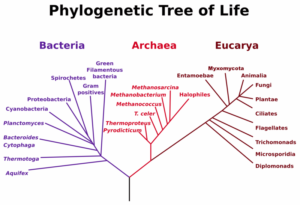
What’s true of E. coli is true of all of Domain Bacteria. It’s true of Domain Archaea as well. In other words, for two of the three domains of life, the biological species concept doesn’t work.
Even in eukaryotes, the biological species can’t always be applied. The animal shown on the left below is a rotifer. Rotifers are tiny freshwater animals (less than a millimeter in size). An entire class of rotifers (the Bdelloidea) consist of over 450 species that are exclusively asexual, which means that they reproduce without sex. In these species, females produce daughters through parthenogenesis, a process by which unfertilized eggs can develop into new individuals without meiosis, recombination, or combining of haploid genomes through fertilization. It’s estimated that these species have been asexual for the past 25 million years (source: Wikipedia). On the right below is the desert whiptail lizard, a species that consists exclusively of females that also reproduces parthenogenetically (click here to read more about these lizards in a new tab). As with all the organisms in domain Bacteria and Archaea, there’s no breeding that happens in these species, so the interbreeding criterion of the biological species can’t be applied.
|
Two exclusively asexual animal species |
|
|
|
|
Here’s another limit for the biological species concept. Look at the two triceratops skeletons below. Are they representatives of two species, or one? Obviously, there’s no way to know if they could have interbred. That, of course, is also true of all of the thousands of species that we only know about through their fossil remains.
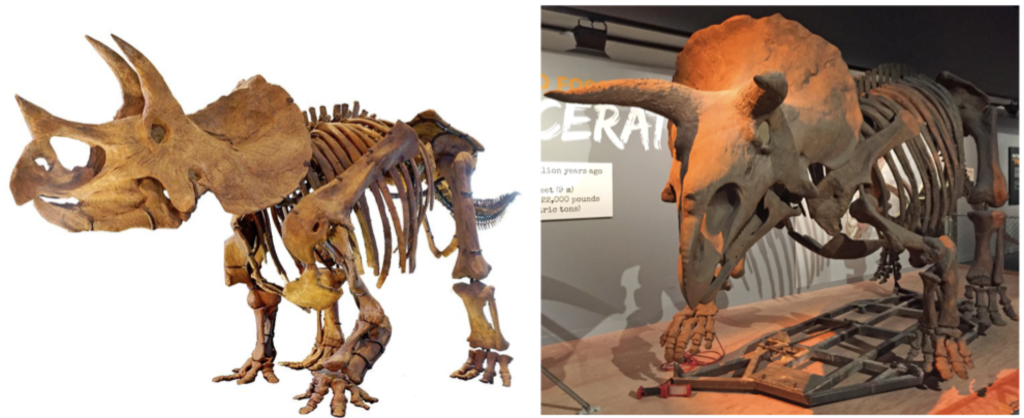
When the biological species concept can’t be applied, biologists use a few other species concepts. We’ll look at three of them.
6b. Morphological species
Morphology is the study of form. A morphological species is a group of organisms that have a shared phenotype. If you’ve ever gone birding, or used a field guide to identify the wildflowers in your local area, then you’ve used a morphological species approach. Based on morphology, for example, the two triceratops species are thought to belong to two different species: Triceratops prorsus (left), and Triceratops horridus (right).
6c. Phylogenetic species

Phylogeny is “the evolution of a genetically related group of organisms.” (Merriam Webster). A phylogenetic species is the tip of a distinct branch on a phylogenetic tree (UC Berkeley, Evolution). Such species can be identified by shared homologous features (which can be anatomical or molecular). DNA sequencing, for example, could be used as evidence to group the rotifers described above into the same species. Or, to think about this more generally, the species at the tip of lineage “A” in the phylogenetic tree at left would be distinct from other rotifer species that have a different genetic, molecular, and morphological profile (“b” and “c”).
6d. Chronospecies
Let’s embark on a thought experiment. If you went back in time 10,000 years, you’d find yourself in a world where agriculture was a relatively new thing. But if you could get a set of clothes from the villagers in the village where your time machine landed, and grew your hair to look like theirs, along with adopting whatever style of jewelry or other adornment they might have been into, you’d fit right in. If you decided to ditch your time machine and stay, you could find a mate. After all, these villagers would be, like you, members of Homo sapiens. You could have children, and contribute to their gene pool.
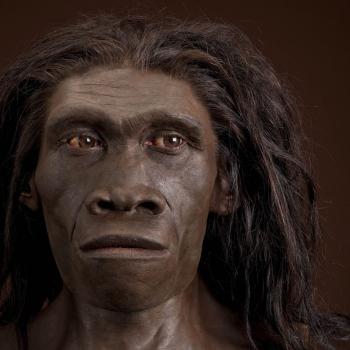
Now, reset your time machine. Go back 1,000,000 years. Fitting in with these bipedal, not-quite-human ancestors would be tougher. You’d be morphologically different. Underlying these morphological differences would be genetic differences. The people you’d encounter might not be … people.
You probably get where I’m going. At a certain point, you wouldn’t be able to interbreed with members of your own ancestral population. At some point, you’d have to say that your ancestors were members of a different species than the one that you belong to. But there’s no firm line. There’s just evolution over time, with the morphological and genetic differences that accompany it.
That’s what a chronospecies is: Read this passage (slightly adapted from Wikipedia) and study the accompanying diagram.
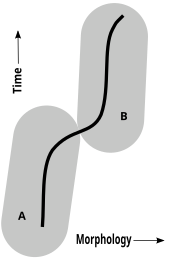
A chronospecies is a species that gradually evolves over time from an extinct ancestral form on an evolutionary time scale. This succession of alterations eventually produces a population (such as species B in the diagram at right) which is physically, morphologically, and/or genetically distinct from the original ancestors (species A). Throughout this change, there is only one species in the lineage at any point in time, as opposed to cases where divergent evolution produces contemporary species with a common ancestor (wikipedia).
7. What is a Species: Checking Understanding
For now, that’ll do it in terms of:
- Understanding the biological species concept.
- Differentiating species from breed, subspecies, or variety.
- Understanding binomial nomenclature.
- Distinguishing between pre-zygotic and post-zygotic reproductive barriers.
- Examining the limitations of the biological species concept, and looking at some alternatives (the morphological species concept, the phylogenetic species concept, and chronospecies).
In the next tutorial, we’ll look at how speciation occurs. But before moving onto that, let’s review all of the concepts explored above.
[qwiz random = “true” qrecord_id=”sciencemusicvideosMeister1961-What is a Species, CFU”]
[h]What is a species? Checking Understanding
[i]
[q]A defining feature of a species is that it’s a population that’s genetically __________ from other species.
[hangman]
[c]aXNvbG F0ZWQ=[Qq]
[q]In the biological species concept, all the reproductively active members of a species can interbreed to produce _________ offspring.
[hangman]
[c]ZmVydG lsZQ==[Qq]
[q]Collies, dachshunds, and Kerry Blue Terriers aren’t species: they’re domesticated ____________.
[hangman]
[c]YnJl ZWRz[Qq]
[q]Every species has a two part name called a __________.
[hangman]
[c]Ymlub2 1pYWw=[Qq]
[q]A natural, genetically distinct and often geographically identifiable sub-population of a species.
[hangman]
[c]c3Vic3Bl Y2llcw==[Qq]
[q]For a domesticated species, this means the same as breed. In nature, this is synonymous with subspecies.
[hangman]
[c]dmFyaW V0eQ==[Qq]
[q]These barriers help keep closely related species from interbreeding.
[hangman]
[c]cmVwcm9k dWN0aXZl[Qq]
[q]Reproductive barriers prevent the flow of ___________ between species.
[hangman]
[c]Z2Vu ZXM=[Qq]
[q]This kind of barrier includes a bird’s song, or the courtship dance of Drosophila.
[hangman]
[c]YmVoYXZp b3JhbA==[Qq]
[q]Barriers that prevent formation of an embryo (note: skip the “-” in your answer).
[hangman]
[c]cHJlenln b3RpYw==[Qq]
[q]This kind of barrier could involve seasons, or moments in the lunar cycle, or time of day.
[hangman]
[c]dGVtcG 9yYWw=[Qq]
[q]A mule is a healthy and valuable animal, but it can’t reproduce. This is an example of hybrid
[hangman]
[c]c3Rlcm lsaXR5[Qq]
[q]The reproductive barrier that’s analogous to the lock and key model of enzyme/substrate interaction.
[hangman]
[c]bWVjaGFu aWNhbA==[Qq]
[q]Two finch species live on the same island. One feeds on cacti, while one prefers areas with seed producing shrubs. The reproductive barrier is about their
[hangman]
[c]aGFiaX RhdA==[Qq]
[q]When the first generation of hybrids is healthy, but the second is sterile or inviable, the barrier is hybrid
[hangman]
[c]YnJlYW tkb3du[Qq]
[q]The biological species can only work with species that reproduce
[hangman]
[c]c2V4dW FsbHk=[Qq]
[q]In the three domain system, this is the only domain where the biological species concept applies.
[hangman]
[c]ZXVrYXJ5 b3Rlcw==[Qq]
[q]With _______ populations like dinosaurs, you can’t use the biological species concept.
[hangman]
[c]ZXh0aW 5jdA==[Qq]
[q]This species concept sees a species as the tip of a branch in an evolutionary tree.
[hangman]
[c]cGh5bG9n ZW5ldGlj[Qq]
[q]This species concept is based on appearance, or phenotype.
[hangman]
[c]bW9ycGhvbG 9naWNhbA==[Qq]
[q]The binomial for the Galapagos ground finch is Geospiza fortis. Geospiza indicates this species’
[hangman]
[c]Z2Vu dXM=[Qq]
[q]A species grouping that emerges as a result of evolutionary changes over long spans of time.
[hangman]
[c]Y2hyb25vc3 BlY2llcw==[Qq]
[x][restart]
[/qwiz]
Links
- Allopatric speciation (the next tutorial in this module)
- Species, Speciation and Extinction Menu

